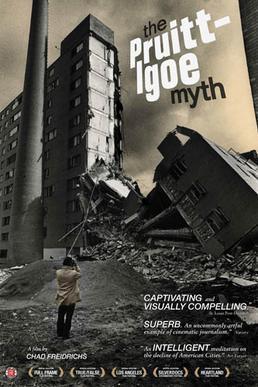The Pruitt-Igoe Myth facts for kids
Quick facts for kids The Pruitt-Igoe Myth: An Urban History |
|
|---|---|
 |
|
| Directed by | Chad Freidrichs |
| Produced by | Paul Fehler, Chad Freidrichs, Jaime Freidrichs, Brian Woodman |
| Written by | Chad Freidrichs, Jaime Freidrichs |
| Release date(s) | February 11, 2011 (Oxford Film Festival) |
| Running time | 79 minutes |
| Country | United States |
| Language | English |
| Money made | $44,683 |
The Pruitt-Igoe Myth is a documentary film from 2011. It tells the story of a large public housing complex called Pruitt–Igoe in St. Louis, Missouri. The film explains why this complex was built and why it was eventually torn down in 1976.
The documentary suggests that the problems at Pruitt-Igoe were not caused by the people living there. Instead, it argues that bigger issues in St. Louis led to its failure. These issues included the city losing jobs and money. This meant there wasn't enough money to keep the buildings in good shape.
About the Film
This film is a documentary, which means it tells a true story using facts and real interviews. It was directed by Chad Freidrichs. The movie explores the history of the Pruitt-Igoe housing complex.
The film's main idea is that Pruitt-Igoe's problems were linked to bigger changes happening in St. Louis. As the city's economy struggled, fewer jobs were available. This made it hard for residents to pay rent, which meant less money for building repairs and safety.
What Was Pruitt-Igoe?
Pruitt-Igoe was a huge public housing project built in St. Louis. It was designed to provide affordable homes for many families. The complex had thirty-three tall buildings, each with 11 floors. A famous architect named Minoru Yamasaki designed them. He later designed the original World Trade Center in New York City.
The Story of Pruitt-Igoe
The film shares how people felt when they first moved into Pruitt-Igoe. Many residents were excited to live in new, modern apartments. They had moved from older, crowded tenement buildings.
However, conditions in the buildings slowly got worse during the 1960s and early 1970s. The film uses interviews with former residents. It also shows old pictures and videos to tell this story. It explains how problems like broken furnaces and plumbing made life difficult. This led to residents stopping their rent payments.
Why Pruitt-Igoe Failed
Many people have tried to explain why Pruitt-Igoe failed. Some thought it was because of the way the buildings were designed. Others blamed the idea of public housing itself.
However, The Pruitt-Igoe Myth offers a different reason. It argues that the complex failed because St. Louis was losing people and industries. After World War II, many jobs left the city. This meant fewer jobs for the people who stayed.
The film explains that the money for maintaining the buildings was supposed to come from rent payments. But as people became poorer and jobs disappeared, it was harder for them to pay. This lack of money meant the buildings could not be properly maintained. This led to the complex's eventual demolition between 1972 and 1976.

